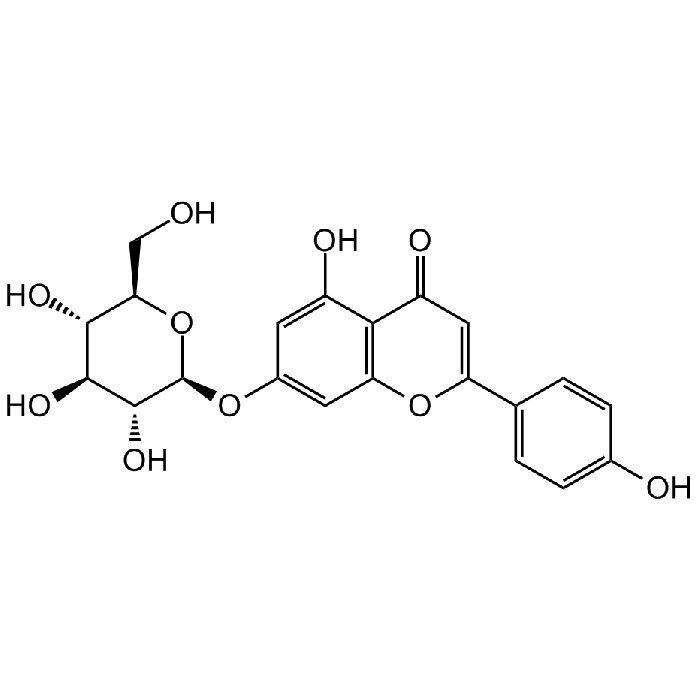Cookie Policy: This site uses cookies to improve your experience. You can find out more about our use of cookies in our Privacy Policy. By continuing to browse this site you agree to our use of cookies.
Chemodex
Apigenin 7-glucoside

| Product Details | |
|---|---|
| Synonyms | Apigetrin; Cosmosiin; 4',5,7-Trihydroxyflavone 7-glucoside; 7-O-β-D-Glucopyranosylapigenin; Apigenin-7-O-β-D-glucoside; NSC 407303 |
| Product Type | Chemical |
| Properties | |
| Formula |
C21H20O10 |
| MW | 432.38 |
| CAS | 578-74-5 |
| Source/Host Chemicals | Plant |
| Purity Chemicals | ≥97% (HPLC) |
| Appearance | Light yellow powder. |
| Solubility | Soluble in DMSO (5mg/ml) or DMF. |
| Identity | Determined by 1H-NMR. |
| Declaration | Manufactured by Chemodex. |
| Other Product Data |
Click here for Original Manufacturer Product Datasheet |
| InChi Key | KMOUJOKENFFTPU-QNDFHXLGSA-N |
| Smiles | O[C@H]1[C@H](O)[C@@H](CO)O[C@@H](OC2=CC(OC(C3=CC=C(O)C=C3)=CC4=O)=C4C(O)=C2)[C@@H]1O |
| Shipping and Handling | |
| Shipping | AMBIENT |
| Short Term Storage | -20°C |
| Long Term Storage | -20°C |
| Handling Advice | Protect from light and moisture. |
| Use/Stability | Stable for at least 2 years after receipt when stored at -20°C. |
| Documents | |
| Product Specification Sheet | |
| Datasheet |
 Download PDF Download PDF |
Apigenin 7-glucoside is a flavonoid with anti-inflammatory, antioxidant, anticancer, anti-adipogenic and anxiolytic activities. It has been shown to inhibit LPS-induced nitric oxide production in RAW 264.7 cells or have hepatoprotective activity due to it's antioxidant activities, acting as scavengers of ROS. Apigenin 7-glucoside has been shown to have anti-proliferative activity, possible through cell cycle inhibition and consequently induce apoptosis. it also has the ability to enhance melanogenesis synthesis and tyrosinase activity of B16F10 melanoma cells. Apigenin 7-glucoside has shown neuroprotective effects possibly by inhibiting neuroinflammation and its antioxidant activity. Apigenin-7-O-glucoside inhibits adipogenesis of 3T3-L1 preadipocytes at early stage of adipogenesis at high concentrations, by downregulating PPARγ and CEBP-α.
(1) J. Fuchs & R. Milbradt; Arzneimittelforschung 43, 370 (1993) | (2) Q.S. Zheng, et al.; Biomed. Environ. Sci. 18, 65 (2005) | (3) E. Nakazaki, et al.; Eur. J. Nutr. 52, 25 (2013) | (4) D. Kumar & Z.A. Bhat; Phytomedicine 21, 1010 (2014) | (5) N. Nasr Bouzaiene, et al.; Life Sci. 144, 80 (2016) | (6) H.S. Lim, et al.; J. Med. Food 19, 1032 (2016) | (7) Q. Sun, et al.; BBRC 498, 164 (2018) | (8) F. Hadrich & S. Sayadi; Lipids Health Dis. 17, 95 (2018) | (9) H. Guo, et al.; Biomed. Pharmacother. 109, 1978 (2019)





